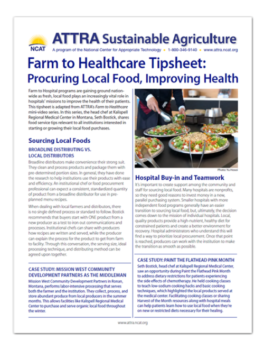Farm to Healthcare Tipsheet: Procuring Local Food, Improving Health
By Lizzie Gill, NCAT Montana Local Foods Specialist
Farm to Hospital programs are gaining ground nationwide as fresh, local food plays an increasingly vital role in hospitals’ missions to improve the health of their patients. This tipsheet is adapted from ATTRA’s Farm to Healthcare mini-video series. In this series, the head chef at Kalispell Regional Medical Center in Montana, Seth Bostick, shares food service tips relevant to all institutions interested in starting or growing their local food purchases.
Sourcing Local Foods
Broadline Distributing vs. Local Distributors
Broadline distributors make convenience their strong suit. They clean and process products and package them with pre-determined portion sizes. In general, they have done the research to help institutions use their products with ease and efficiency. An institutional chef or food procurement professional can expect a consistent, standardized quantity of product from a broadline distributor for use in pre-planned menu recipes.
When dealing with local farmers and distributors, there is no single defined process or standard to follow. Bostick recommends that buyers start with ONE product from a new producer as a test to iron out communications and processes. Institutional chefs can share with producers how recipes are written and served, while the producer can explain the process for the product to get from farm to facility. Through this conversation, the serving size, ideal processing technique, and distributing method can be agreed upon together.
Case Study: Mission West Community Development Partners as the Middleman
Mission West Community Development Partners in Ronan, Montana, performs labor-intensive processing that serves both the farmer and the institution. They collect, process, and store abundant produce from local producers in the summer months. This allows facilities like Kalispell Regional Medical Center to purchase and serve organic local food throughout the winter.
Hospital Buy-in and Teamwork
It’s important to create support among the community and staff for sourcing local food. Many hospitals are nonprofits, so they need good reasons to invest money in a new, parallel purchasing system. Smaller hospitals with more independent food programs generally have an easier transition to sourcing local food, but, ultimately, the decision comes down to the mission of individual hospitals. Local, quality products provide a high-nutrient, healthy diet for constrained patients and create a better environment for recovery. Hospital administrators who understand this will find a way to prioritize local procurement. Once that point is reached, producers can work with the institution to make the transition as smooth as possible.
Case Study: Paint the Flathead Pink Month
Seth Bostick, head chef at Kalispell Regional Medical Center, saw an opportunity during Paint the Flathead Pink Month to address dietary restrictions for patients experiencing the side effects of chemotherapy. He held cooking classes to teach low-sodium cooking hacks and basic cooking techniques, which highlighted the local products served at the medical center. Facilitating cooking classes or sharing Harvest of the Month resources along with hospital meals can help patients learn how to use local food when they’re on new or restricted diets necessary for their healing.
Affordability and Price Points
Because they don’t always benefit from economies of scale, local farmers might need to ask for a higher price point than the broadline distributors. Sometimes, taking out the intermediary compensates for this price difference. But, either way, it is likely that a hospital looking to buy local will have to pay a premium. Because of this, it is important to prioritize local purchases based on the answers to the following questions: Which products will have the most value to the facility? The most value for the health of the client? The best flavor profile for a dish? Which will be the most noticeable to the patient?
Storing Locally Sourced Foods
In general, local product is much more variable and less streamlined than product from broadline distributors. Therefore, institutions may need to practice more flexibility to accommodate varying box sizes and produce bags. This can mean incorporating new produce-storage systems that require unpacking upon delivery or moving products such as melons, citrus, and potatoes to room temperature storage if refrigerated space is lacking. As Bostick put it, “You just work with the product itself, pay attention to it as it comes through the door, and don’t take it for granted.” This can require hospitals to be flexible, to try new systems, and to train their staff in new ways. By contrast, there are few changes that need to occur with utilizing local frozen proteins.

Photo: Simona Sergi
Kitchen Capacity and Labor
Many local products are less processed than broadline distributed goods. This can create more or less labor on the institution’s end. The questions are how much extra labor time is required and is that financially sustainable to support? For example, a local farm may be willing to provide dry beans in 25-pound bags and at a price comparable to the canned product a hospital is already buying. Yet, rehydrating dry beans on the stove can take time and stove space.
Final Thoughts
Overall, there are numerous hurdles to jump in order to be successful with incorporating new local products into institutional food service programs. Institutions that find the patience and energy to overcome those barriers find benefits that extend even beyond their own organization, from the pocket of local producers to the health of patients.
Labor Test
How much labor (in dollars per hour) does it take to prepare the new product? + How much extra (in dollars) did the product cost?
Example: Seth Bostick purchases local organic carrots for the Kalispell Regional Medical Center. As Seth puts it, “They’re nice, they’re natural, and they’re supposed to be that way.” He washes them and coins them to roast and serve without having to peel them. Ideally, the elevated price can be diminished through the lower labor requirements of not having to peel the carrots. In Seth’s experience, these costs offset each other, but there are also many examples of more expensive products that require higher labor costs. It is good for institutional buyers to keep an eye on how labor costs and kitchen capacity affect the economics of local foods.
Further Resources
Montana Harvest of the Month Program
Farm to Healthcare Tipsheet: Procuring Local Food, Improving Health
By Lizzie Gill, NCAT Montana Local Foods Specialist
Published June 2021
©NCAT
IP611


